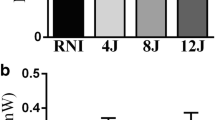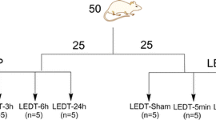Abstract
The use of low-level laser therapy (LLLT) represents a new intervention modality that has been explored to enhance exercise performance. The aim of this study was to evaluate the influence of LLLT (GaAIAs—850 nm) at different doses on VO2max and on exercise performance in rats. Male Wistar rats were divided into three groups: “placebo” rats (P-LLLT, n = 10), rats at a dose of 0.315 J per treatment point of LLLT (8.7 J/cm2-LLLT, n = 10), and rats at a dose of 2.205 J per treatment point of LLLT (61.2 J/cm2-LLLT, n = 10). The LLLT was applied bilaterally at the biceps femoris, gluteus, lateral and medial gastrocnemius, iliopsoas, and adductor longus muscles. One spot in each muscle belly was applied, with a sum of 12 spots in each rat, once a day, for 10 days. All animals performed the maximal exercise test (ET) at a metabolic treadmill for rats, with simultaneous gas analysis. The distance covered was measured during ET, before and after the conclusion of the LLLT protocol. The data were compared by a repeated measures two-way ANOVA followed by the Student-Newman-Keuls post hoc tests (p < .05). The 61.2 J/cm2-LLLT group increased VO2basal (~40 %), VO2max (~24 %), VCO2max (~17 %), and distance covered (~34 %) after LLLT application on the skeletal muscle. No significant results were found comparing before and after conditions for the studied variables considering P-LLLT and 8.7 J/cm2-LLLT groups. The LLLT promoted in a dose-dependent manner an increase in oxygen consumption uptake and a performance increment of male Wistar rats.



Similar content being viewed by others
References
Chung H, Dai T, Sharma SK, Huang YY, Carroll JD, Hamblin MR (2012) The nuts and bolts of low-level laser (light) therapy. Ann Biomed Eng 40(2):516–533
Hurkmans EJ, Jones A, Li LC, Vliet Vlieland TP (2011) Quality appraisal of clinical practice guidelines on the use of physiotherapy in rheumatoid arthritis: a systematic review. Rheumatology (Oxford, England) 50(10):1879–1888
Kingsley JD, Demchak T, Mathis R (2014) Low-level laser therapy as a treatment for chronic pain. Front Physiol 5:306
Nesioonpour S, Mokmeli S, Vojdani S et al (2014) The effect of low-level laser on postoperative pain after tibial fracture surgery: a double-blind controlled randomized clinical trial. Anesth Pain Med 4(3), e17350
Beckmann KH, Meyer-Hamme G, Schroder S (2014) Low level laser therapy for the treatment of diabetic foot ulcers: a critical survey. Evid Based Complement Alternat Med 2014:626127
Aggarwal H, Singh MP, Nahar P, Mathur H, Gv S (2014) Efficacy of low-level laser therapy in treatment of recurrent aphthous ulcers—a sham controlled, split mouth follow up study. J Clin Diagn Res 8(2):218–221
Liu BS, Huang TB, Chan SC (2014) Roles of reinforced nerve conduits and low-level laser phototherapy for long gap peripheral nerve repair. Neural Regen Res 9(12):1180–1182
Hentschke VS, Jaenisch RB, Schmeing LA, Cavinato PR, Xavier LL, Dal Lago P (2013) Low-level laser therapy improves the inflammatory profile of rats with heart failure. Lasers Med Sci 28(3):1007–1016
Biasibetti M, Rojas DB, Hentschke VS et al (2014) The influence of low-level laser therapy on parameters of oxidative stress and DNA damage on muscle and plasma in rats with heart failure. Lasers Med Sci 29(6):1895–1906
Huang YY, Chen AC, Carroll JD, Hamblin MR (2009) Biphasic dose response in low level light therapy. Dose-Response: a publication of International Hormesis Society 7(4):358–383
Ferraresi C, de Brito OT, de Oliveira ZL et al (2011) Effects of low level laser therapy (808 nm) on physical strength training in humans. Lasers Med Sci 26(3):349–358
Leal-Junior EC, Vanin AA, Miranda EF, de Carvalho PT, Dal Corso S, Bjordal JM (2015) Effect of phototherapy (low-level laser therapy and light-emitting diode therapy) on exercise performance and markers of exercise recovery: a systematic review with meta-analysis. Lasers Med Sci 30(2):925–39
Leal Junior EC, Lopes-Martins RA, Baroni BM et al (2009) Effect of 830 nm low-level laser therapy applied before high-intensity exercises on skeletal muscle recovery in athletes. Lasers Med Sci 24(6):857–863
Leal Junior EC, Lopes-Martins RA, Frigo L et al (2010) Effects of low-level laser therapy (LLLT) in the development of exercise-induced skeletal muscle fatigue and changes in biochemical markers related to postexercise recovery. J Orthop Sports Phys Ther 40(8):524–532
Leal Junior EC, Lopes-Martins RA, de Almeida P, Ramos L, Iversen VV, Bjordal JM (2010) Effect of low-level laser therapy (GaAs 904 nm) in skeletal muscle fatigue and biochemical markers of muscle damage in rats. Eur J Appl Physiol 108(6):1083–1088
De Marchi T, Leal Junior EC, Bortoli C, Tomazoni SS, Lopes-Martins RA, Salvador M (2012) Low-level laser therapy (LLLT) in human progressive-intensity running: effects on exercise performance, skeletal muscle status, and oxidative stress. Lasers Med Sci 27(1):231–236
Amadio EM, Serra AJ, Guaraldo SA et al (2015) The action of pre-exercise low-level laser therapy (LLLT) on the expression of IL-6 and TNF-alpha proteins and on the functional fitness of elderly rats subjected to aerobic training. Lasers Med Sci 30(3):1127–1134
Batista ML Jr, Santos RV, Oliveira EM, Seelaender MC, Costa Rosa LF (2007) Endurance training restores peritoneal macrophage function in post-MI congestive heart failure rats. J Appl Physiol (1985) 102(5):2033–2039
Rodrigues B, Figueroa DM, Mostarda CT, Heeren MV, Irigoyen MC, De Angelis K (2007) Maximal exercise test is a useful method for physical capacity and oxygen consumption determination in streptozotocin-diabetic rats. Cardiovasc Diabetol 6:38
Rodrigues B, Mostarda CT, Jorge L et al (2013) Impact of myocardial infarction on cardiac autonomic function in diabetic rats. J Diabetes Complicat 27(1):16–22
Rodrigues B, Jorge L, Mostarda CT et al (2012) Aerobic exercise training delays cardiac dysfunction and improves autonomic control of circulation in diabetic rats undergoing myocardial infarction. J Card Fail 18(9):734–744
Campos JC, Queliconi BB, Dourado PM et al (2012) Exercise training restores cardiac protein quality control in heart failure. PloS one 7(12), e52764
Louzada RA, Oliveira PF, Cavalcanti-de-Albuquerque JP et al (2010) Granulocyte-colony stimulating factor treatment of chronic myocardial infarction. Cardiovasc Drugs Ther 24(2):121–130
Lima JW, Hentschke VS, Rossato DD, Quagliotto E, Pinheiro L, Almeida Jr E, Dal Lago P, Lukrafka JL. Chronic electroacupuncture of the ST36 point improves baroreflex function and haemodynamic parameters in heart failure rats. Autonomic Neuroscience. May 2015; In Press.
Santos LA, Marcos RL, Tomazoni SS et al (2014) Effects of pre-irradiation of low-level laser therapy with different doses and wavelengths in skeletal muscle performance, fatigue, and skeletal muscle damage induced by tetanic contractions in rats. Lasers Med Sci 29(5):1617–1626
Antonialli FC, De Marchi T, Tomazoni SS et al (2014) Phototherapy in skeletal muscle performance and recovery after exercise: effect of combination of super-pulsed laser and light-emitting diodes. Lasers Med Sci 29(6):1967–1976
Baroni BM, Rodrigues R, Freire BB, Franke Rde A, Geremia JM, Vaz MA (2015) Effect of low-level laser therapy on muscle adaptation to knee extensor eccentric training. Eur J Appl Physiol 115(3):639–647
Albertini R, Aimbire FS, Correa FI et al (2004) Effects of different protocol doses of low power gallium-aluminum-arsenate (Ga-Al-As) laser radiation (650 nm) on carrageenan induced rat paw ooedema. J Photochem Photobiol B 74(2–3):101–107
Boschi ES, Leite CE, Saciura VC et al (2008) Anti-Inflammatory effects of low-level laser therapy (660 nm) in the early phase in carrageenan-induced pleurisy in rat. Lasers Surg Med 40(7):500–508
Albertini R, Villaverde AB, Aimbire F et al (2007) Anti-inflammatory effects of low-level laser therapy (LLLT) with two different red wavelengths (660 nm and 684 nm) in carrageenan-induced rat paw edema. J Photochem Photobiol B 89(1):50–55
Buravlev EA, Zhidkova TV, Vladimirov YA, Osipov AN (2013) Effects of laser and LED radiation on mitochondrial respiration in experimental endotoxic shock. Lasers Med Sci 28(3):785–790
Wong-Riley MT, Liang HL, Eells JT et al (2005) Photobiomodulation directly benefits primary neurons functionally inactivated by toxins: role of cytochrome c oxidase. J Biol Chem 280(6):4761–4771
Hayworth CR, Rojas JC, Padilla E, Holmes GM, Sheridan EC, Gonzalez-Lima F (2010) In vivo low-level light therapy increases cytochrome oxidase in skeletal muscle. Photochem Photobiol 86(3):673–680
Albuquerque-Pontes GM, Vieira Rde P, Tomazoni SS et al (2015) Effect of pre-irradiation with different doses, wavelengths, and application intervals of low-level laser therapy on cytochrome c oxidase activity in intact skeletal muscle of rats. Lasers Med Sci 30(1):59–66
Myers J, Gullestad L, Vagelos R et al (2000) Cardiopulmonary exercise testing and prognosis in severe heart failure: 14 mL/kg/min revisited. Am Heart J 139(1 Pt 1):78–84
Yancy CW, Jessup M, Bozkurt B et al (2013) 2013 ACCF/AHA guideline for the management of heart failure: a report of the American College of Cardiology Foundation/American Heart Association Task Force on Practice Guidelines. J Am Coll Cardiol 62(16):e147–239
Acknowledgments
We would like to thank Giuseppe Potrick Stefani, Jadson Pereira Alves, and Jéssica Willing Lima for their technical support.
Author information
Authors and Affiliations
Corresponding author
Ethics declarations
The animals were cared for in accordance with the Arouca Brazilian Law (11794/2008) supported by the Decree number 6.899 of 15 July 2009, which defines the composition of the National Council for the Control of Animal Experimentation, as well the International Guiding Principles for Biomedical Research Involving Animals developed by the Council for International Organization of Medical Sciences (CIOMS). Moreover, the study methods were in compliance with the Ethics and Research Committee on Animal Use of UFCSPA (protocol 140/13).
Financial support
This study was supported by the Coordenação de Aperfeiçoamento de Pessoal de Nível Superior (CAPES), by the Conselho Nacional de Desenvolvimento Científico e Tecnológico (CNPq), and by the Fundação de Amparo à Pesquisa do Estado do Rio Grande do Sul (FAPERGS), Brazil.
Conflict of interest
The authors declare that they have no competing interests.
Rights and permissions
About this article
Cite this article
Perini, J.L., Scotta Hentschke, V., Sonza, A. et al. Long-term low-level laser therapy promotes an increase in maximal oxygen uptake and exercise performance in a dose-dependent manner in Wistar rats. Lasers Med Sci 31, 241–248 (2016). https://doi.org/10.1007/s10103-015-1849-8
Received:
Accepted:
Published:
Issue Date:
DOI: https://doi.org/10.1007/s10103-015-1849-8




